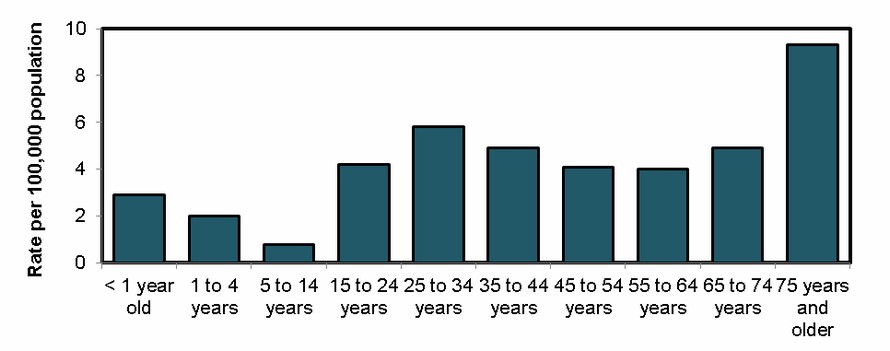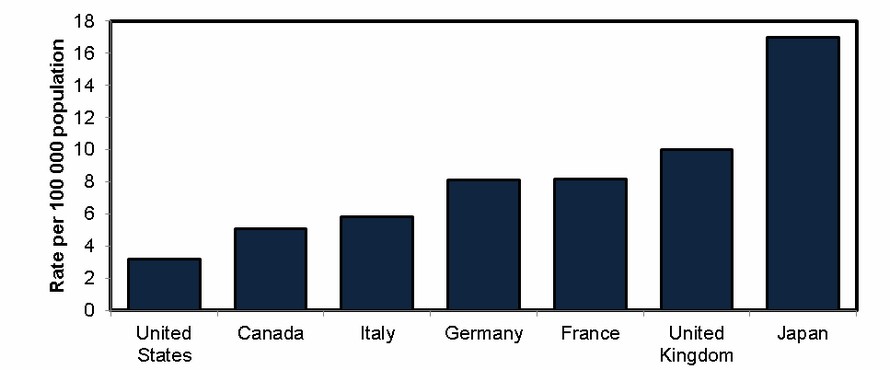Health Status of Canadians 2016: Report of the Chief Public Health Officer - How are we unhealthy? - Tuberculosis
How are we unhealthy?
Tuberculosis
In 2014, 1,568 new and re-treatment cases of tuberculosis (TB) were reported in Canada, resulting in a rate of just over 4 per 100,000 population.Footnote 1
Tuberculosis (TB) is a curable bacterial infection that spreads from person to person primarily through the air.Footnote 2
Did you know?
Drug-resistant TB is a major global public health issue. Rates of drug-resistant TB are currently low in Canada.Footnote 3
Over time
The number and rates of new TB cases have been decreasing.Footnote 1
- 1,612 new or re-treatment cases in 2004 for a rate of 5 per 100,000 population.
- 1,568 new or re-treatment cases in 2014 for a rate of just over 4 per 100,000 population.
By income
Data at a national level are not available on TB by income. Research has shown that living in a low-income household is one of the risk factors for the transmission of TB.Footnote 4
By sex
In 2014, rates of TB were 5 new or re-treatment cases per 100,000 population for men and 4 per 100,000 population for women.Footnote 1
By age
In 2014, rates of new or re-treated cases of TB were lowest in children and highest in people 75 years and older (see Figure 1)Footnote 1.

Text Equivalent
Bar graph showing the rate of new or re-treatment cases of TB by age group in 2014.
- Less than 1 year old: 2.9 per 100,000 population
- 1 to 4 years: 2 per 100,000 population
- 5 to 14 years: 0.8 per 100,000 population
- 15 to 24 years: 4.2 per 100,000 population
- 25 to 35 years: 5.8 per 100,000 population
- 35 to 44 years: 4.9 per 100,000 population
- 45 to 54 years: 4.1 per 100,000 population
- 55 to 64 years: 4 per 100,000 population
- 65 to 74 years: 4.9 per 100,000 population
- 75 years and older: 9.3 per 100,000 population
Indigenous populations
In 2014, Indigenous populations made up 4% of the total Canadian population, but accounted for 21% of reported cases of TB. This resulted in a rate of 20 new or re-treatment cases per 100,000 of the Indigenous population.Footnote 1 Rates vary across Indigenous populations. The rate of TB among Inuit is almost 50 times higher than the overall Canadian rate.Footnote 1
| Rate per 100,000 | |
|---|---|
| First Nations | 19 |
| on reserve | 20 |
| off reserve | 15 |
| Métis | 3 |
| Inuit | 198 |
| Indigenous (overall) | 20 |
| Canada (overall) | 4 |
In 2014, the foreign-born population, which represented approximately 22% of the total Canadian population, accounted for 69% of reported new or re-treatment cases of TB for rate of almost 14 cases per 100,000 population.Footnote 1
International comparison
In 2015, there was an estimated 10 million new cases of TB across the world.Footnote 5 In G7 countries, Canada had the second lowest rate of new cases of TB at just over 4 cases per 100,000 population.Footnote 6 The United States had the lowest rate at 3 per 100,000 population while Japan had the highest at 17 per 100,000 population (see Figure 2)Footnote 6.

Text Equivalent
Bar graph showing the rate of new cases of TB in G7 countries in 2015.
- Canada: 5.1 per 100,000 population
- United States: 3.2 per 100,000 population
- United Kingdom: 10 per 100,000 population
- France: 8.2 per 100,000 population
- Germany: 8.1 per 100,000 population
- Italy: 5.8 per 100,000 population
- Japan: 17 per 100,000 population
Notes to the reader
- Annual rates of TB are calculated by using the number of new active and re-treatment cases each year. A re-treatment case occurs when a person who was previously diagnosed with TB has a second diagnosis of TB (i.e., reactivated or new infection). To be considered a re-treatment case, the disease must have been inactive for at least six months between the first and second diagnosis.Footnote 1
- Indigenous populations consist of First Nations, Métis and Inuit.
- G7 countries include seven of the world's industrialized countries, namely the United States, Japan, Germany, France, the United Kingdom, Italy and Canada, that form an informal discussion group and economic partnership.